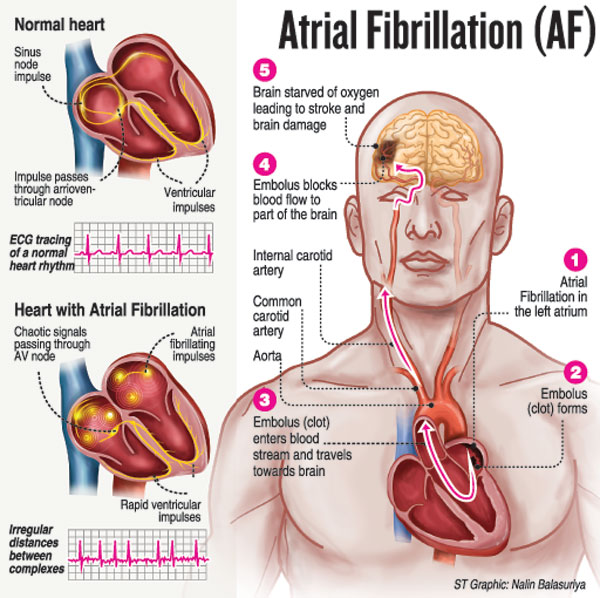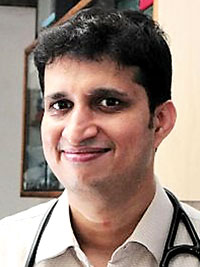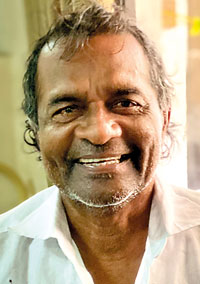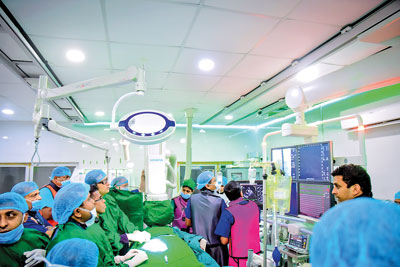This amulet is more than a lucky charm

They step into the New Year of 2020 with much hope for they are able to leave behind their heart issues.
An ‘amulet’ has come to their aid in an intervention performed for the first time in Sri Lanka.

Dr. Gotabhaya Ranasinghe
Usually, an amulet is a piece of jewellery that some people wear because they think it protects them from bad luck and illness but for 51-year-old R.P. Kumudu Nilani of Ja-ela, 70-year-old J.M. Sirisena of Kelaniya and two others, the amulet is in their hearts, warding off serious heart trouble caused by Atrial Fibrillation (AF).
An indication that Kumudu, a mother of two grown-up children was unwell came about two years ago with an “adika kessak” (severe cough) that would not get better even after taking medication. A Montessori teacher she found that she was feeling sleepy during the day.
An ECG (electrocardiogram) pointed to the fact that her heart was not functioning normally and she was put on warfarin, a blood thinning medication. Then one day in April last year she cut her hand (podi thuvalayak of about ½-cm) but the bleeding did not stop even after three days in hospital including getting stitches. It was stemmed only when she was given a transfusion of platelets.
In October, Kumudu was asked whether she would like to undergo a procedure which was brand-new to Sri Lanka by Consultant Cardiologist Dr. Gotabhaya Ranasinghe attached to the Cardiology Institute of the National Hospital of Sri Lanka (NHSL) under whom she is taking treatment for AF.

Dr. Vincent Paul
She readily agreed, as he assured her that she would be able to stop warfarin. In Room 15 of the Cardiology Institute, the staff sent a camera down her throat and she believes that some measurements were taken.

Kumudu Nilani
Kumudu got admitted to the Cardiology Institute and the procedure was performed on November 9, two days after which she was discharged.
“I was the only female to undergo the procedure. The three others were males,” she says, adding that the procedure was done through a small cut in her right groin.
Now Kumudu is off warfarin, there is no cough and she also does not feel sleepy during the day. She takes aspirin at night and will be attending the clinic on January 29 for a check-up.
“I am back at work among the little ones,” she says.
It is Dr. Ranasinghe who tells MediScene why these four patients needed an amulet, how the procedure was performed to insert it and what benefits they would accrue from it.
“All these patients had a quivering or irregular heartbeat (arrhythmia) due to AF,” explains Dr. Ranasinghe, stressing that this condition, a common abnormal heart rhythm, is a major cause of stroke.

Dr. Ranjan K. Shetty
He points out that AF is the most common cardiac arrhythmia and affects 3-5% of the population in the age-group 65-75 years. It causes substantial morbidity (illness) and mortality (death), with its highest complication being stroke which is fatal in many instances and causes severe disability in many more.
With AF, there are also the dangers of heart failure and other heart-related complications, it is learnt.
In those suffering from AF, the risk of stroke increases five-fold compared to the unaffected population, says Dr. Ranasinghe, giving the risk factors for AF as hypertension (high blood pressure), diabetes and age.

J.M. Sirisena
MediScene learns that in AF, electrical impulses (messages) fire off from different places in the atria (the top chambers of the heart) in a disorganized manner.
Delving into how the heart functions, Dr. Ranasinghe says that usually the heart’s pumping action is controlled by tiny electrical messages produced by the ‘sinus node’ which acts as a natural pace-maker. These electrical messages are regular and indicate when to contract and pump blood to the body. This is what gives the heartbeat and pulse. In AF, the firing off of messages becomes disorganized and the atria twitch causing irregular heartbeats and pulse.
Giving MediScene a glimpse into the heart, Dr. Ranasinghe says the left atrium has an appendage like a side-pocket without a known function. When the heart “nicely squeezes” in normal people there is no problem but the frenetic pumping activity in the heart of AF patients makes the blood stagnate in the atria and tends to clot in this appendage. These are the clots which cause stroke when they go to the brain.

A first in Sri Lanka: The amulet procedure underway at the Cardiology Institute
| Fixing that appendageHow should we deal with the appendage or side-pocket in the hearts of patients with Atrial Fibrillation (AF) to prevent the formation of clots which leads to stroke? “We either have to close the appendage or surgically remove it. But heart surgery is cumbersome. As such what we do is, like in the procedure for stenting, we send a small dumb-bell shaped device into the appendage and close it, says Dr. Gotabhaya Ranasinghe. The procedure on the first four patients was performed on November 9 at a workshop for health staff on the use of the Left Atrial Appendage Occlusion Device (LAAOD) with the participation of Consultant Electrophysiologist Dr. Vincent Edward Paul from the Royal Perth Hospital, Australia; Consultant Cardiologist Dr. Rajan K. Shetty from Manipal Hospital, Bangalore in India; and the local cardiology team headed by Dr. Ranasinghe. The procedure – being watched by a packed auditorium of the Cardiology Institute – entailed the patients being administered local anaesthesia in the Catheterization Laboratory and the tube-like LAAOD loaded with the amulet being inserted through the femoral vein to enter the right side of the heart (right atrium). Thereafter, the heart wall between the right and left atria was pierced to get into the left side of the heart (left atrium). The skill of the Cardiologist comes into play when piercing the heart wall as there is a need to create a flap so that it closes as soon as the device passes through as there is high pressure in the left atrium and low pressure in the right atrium, MediScene learns. There could be a major emergency if blood between the two atria mix due to the piercing, says Dr. Ranasinghe. This is why the wall is trabeculated to fit the device, immediately shutting the opening to prevent a mix of blood between the right and left atria. He explains that once the LAAOD is in place at the appendage, the cable is manipulated and the dumb-bell or amulet is unscrewed. It gets detached and fits into the appendage. “The placement is tricky. If the amulet is loose and gets dislodged it can get into the left atria and block the blood flow into the left ventricle and in turn to the aorta which supplies blood to the body. This would be disastrous.” The four patients who have got their very own amulets last year are equipped to face the New Year with confidence. | |


